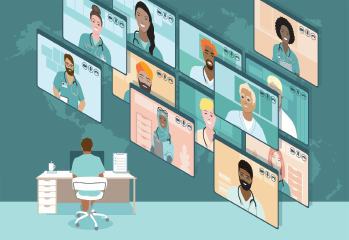
© Tasha Art / shutterstock.com
Although grand rounds have been a vital tool in providing quality clinical education since the introduction of bedside teaching at Johns Hopkins Medical School in the late 1800s, the style, format, and approach that medical schools have taken to hosting these events have all evolved considerably over the decades (J Grad Med Educ. 2013;5:560-563). The latest phase in this evolution occurred in March 2020, when the COVID-19 pandemic effectively eliminated the option of group gatherings and compelled academic programs directors to turn to a virtual format for their grand rounds.
Explore This Issue
February 2021The recent mandatory shift to a virtual grand rounds format is just the latest in a series of changes that the practice has undergone since its inception so many years ago. “The traditional grand rounds format doesn’t carry the same level of high regard that it did 50 years ago, when it was a very formal presentation that took place on Saturday mornings when everybody would show up,” acknowledged Dr. Oghalai. “Nowadays, we all recognize that work-life balance is important and additional time for conferences can adversely affect a physician’s quality of life.”
No one, however, is debating the essential value of grand rounds as an educational tool, both to convey the latest scientific medical knowledge to residents and faculty, and to help residents and medical students learn how to give presentations and gain knowledge of a topic. “Learning and keeping up with most cutting-edge material will always be relevant,” said Nicholas Rowan, MD, assistant professor in the department of otolaryngology–head and neck surgery at Johns Hopkins University School of Medicine in Baltimore. “Furthermore, the dedicated time spent on learning and education is recognized as time well-spent.”
John Oghalai, MD, the Leon J. Tiber and David S. Alpert Professor and chair of the Caruso department of otolaryngology–head and neck surgery at the Keck School of Medicine at the University of Southern California in Los Angeles, emphasized that regular group meetings are a necessary part of team building, which is key in an academic environment.
After a year of holding grand rounds via cybertechnology, the physician-educators charged with making the system work have had time to reflect on how the change from in-person to on-screen has affected this honored practice. It appears that virtual grand rounds are likely here to stay.
Attendance and Reach
In turning to a virtual format via platforms such as Zoom, WebEx, and Teams to conduct their programs’ grand rounds, medical educators note some obvious silver linings. The first and most apparent: better attendance. “At every university I’ve ever been at, it has always been a struggle to get residents and faculty to come to grand rounds, and to be on time,” said Dr. Oghalai. “Since doing grand rounds virtually, attendance has been dramatically better.”
The virtual meeting space has eliminated many constraints, allowing us to host larger sessions than ever before and reach a broader audience. —Nicholas Rowan, MD
The reasons for those filled virtual seats are no mystery, especially in a large, spread-out city like Los Angeles where distance and traffic are major obstacles to early morning appearances. For USC, multiple campuses complicate matters further. “We have faculty that go to different satellite clinics around the city, and it wasn’t feasible for them to come to the main campus for grand rounds and then drive to their satellite clinic,” explained Dr. Oghalai. Now, invitees not only attend via a remote location, but they can actually listen in while commuting.
Even when distance doesn’t impede attendance, schedules often do, said Dr. Rowan. “Between early starts or late finishes to surgical cases, it was always challenging to find one time at which all members of our large department were completely available,” he said. “The virtual meeting space has eliminated many constraints, allowing us to host larger sessions than ever before and reach a broader audience.”
Holding grand rounds virtually also enables institutions to secure otherwise tough-to-get speakers, eliminating the hurdles of time, space, and cost, especially for those who would otherwise need to travel to attend. We’ve been able to invite speakers from across the globe,” said Sonya Malekzadeh, MD, residency program director and professor of otolaryngology–head and neck surgery at Georgetown University Medical Center in Washington, D.C.
Technology and Protocols
Surprisingly, program leaders say they’ve had few major connectivity problems among virtual grand rounds participants. “We were expecting a bigger technical challenge that we ended up having,” said Rodney C. Diaz, MD, professor and residency program director in the department of otolaryngology–head and neck surgery at the University of California Davis Medical Center. “But apart from that 50-millisecond lag with people talking on top of each other, it hasn’t been that bad. There’s an unnaturalness about it but we’ve gotten used to it.”
Some of the technological features of virtual platforms are proving useful during grand rounds sessions. Leaders report using functions such as screen sharing, direct audio-video, question-and-answer polls, and chat to enhance the effectiveness of their grand rounds. “The chat function can be helpful because it allows people to comment in real time and to ask questions that can be answered at the end of the presentation,” said Walter Kutz, MD, professor in the Department of Otolaryngology at University of Texas Southwestern Medical Center in Dallas.
Months of virtual grand rounds have helped program teams develop protocols for smoother implementation. Dr. Rowan notes that preparation on a departmental level is key. “Zoom links are sent well in advance, and we make sure to go over the objectives, timing, and goals with our speaker,” he said. “To avoid technical glitches, we test links, equipment, and slides in advance of the grand rounds sessions.” He adds that there’s always a dedicated moderator who has the ability to mute or unmute participants and speakers to facilitate active dialogue and to minimize disruptions.
Privacy and security are of primary importance when venturing into the virtual world, especially in the context of grand rounds, and adhering to HIPAA rules is paramount. “In cyberspace, you never know who’s out there so we have to be cognizant of how to lock the room and who we allow in and out,” said Dr. Diaz. At UC Davis, the IT person fulfills that role, he noted.
A clear advantage of technology is that it can ensure that content lives on and remains accessible to those who need it. Dr. Oghalai’s department at USC records and posts select, nonconfidential grand rounds on a quarterly basis to enable residents to enjoy unlimited open online access to the material. At Southwestern, grand rounds “are kept on our secure drives so our residents and faculty can view them later,” Dr. Kutz said. UC Davis has adopted a similar approach for its special guest lecturers.
The virtual setting is often a unidirectional flow of information with limited discourse. I think successful grand rounds are those that engage the audience and intentionally involve participation. —Sonya Malekzadeh, MD
Discussion and Content
Any fair comparison of virtual versus in-person grand rounds must address the key aspects of interaction and personal connection, both of which suffer in varying degrees in a virtual format. “A sea of black screens is less inviting than a roomful of colleagues,” observed Dr. Rowan. “As a speaker, it can be hard to engage a virtual audience or gauge its attentiveness. There isn’t much opportunity to feed off the crowd’s energy.”
It’s hard to foster a sense of community over a screen, and even harder to reach out directly to other individuals without disrupting the session. “Grand rounds have traditionally been a venue for me to connect with colleagues and trainees on a personal level and I miss those opportunities for camaraderie and networking,” said Dr. Malekzadeh.
There’s no denying the sense of detachment that’s inherent in the virtual experience. Group discussions can be technically tricky without the benefit of physical cues such as hand raising, eye contact, nodding, and smiling that let a speaker know he or she is connecting, and attendees might err on the side of caution and stay silent. “I think for some people, it’s a bigger hurdle to speak over Zoom than to speak across a table in a conference room. Because of this, there aren’t as many questions or as much discussion as you would have when you’re in a room together,” said Dr. Oghalai.
Although decreased discussion saves time, it limits the opportunity to learn and share ideas, a vital objective of grand rounds. “The virtual setting is often a unidirectional flow of information with limited discourse. I think successful grand rounds are those that engage the audience and intentionally involve participation from as many participants as possible,” said Dr. Malekzadeh. She suggests encouraging use of the chat function within your chosen online meeting platform for questions and answers and implementing polling or other audience response methods several times during the rounds. “Other specialties have introduced ‘open Zooms,’ in which the grand rounds speaker stays in a single Zoom session after the formal grand rounds to meet with a small group for a more in-depth discussion of the topic,” she said.

© PopTika / shutterstock.com
Despite the significant differences between virtual and in-person formats, program directors report that session content has remained unaffected. “The goal of our grand rounds is to provide a rich educational experience for all of our residents and physician educators, and that has remained unchanged from prior to the pandemic,” said Dr. Rowan.
“We seek to be well-versed in relevant topics related to otolaryngology ranging from cutting-edge advances, to the impact of COVID-19 on some of our subspecialities, to other relevant topics such as changes in medical billing and reimbursement practices,” added Dr. Kutz. “I recently spoke in a virtual grand rounds session about my approach to treating chronic otitis media and cholesteatoma. I believe the talk was successful because of the extensive use of surgical videos and illustrations. We also published on this topic, so I was able to present our own data.”
Even with a less-than-compelling topic, an effective speaker can be successful in a virtual setting, said Dr. Rowan. “We recently had Dr. James Lin, an associate professor from the University of Kansas Medical Center, visit us virtually, and he spoke about the development and utilization of current procedural terminology codes and billing practices,” he said. “Though CPT coding may not be the most exciting topic for a surgical audience, Dr. Lin was well prepared with examples that were relevant for our audience. He called on individual attendees and asked relevant questions about their billing practice. Dr. Lin was capable of engaging an audience of approximately 65 individuals and had several questions asked throughout his talk.”
An Ongoing Evolution
Educators agree that the virtual option deserves a permanent—albeit limited—place in the time-honored practice of grand rounds. Dr. Malekzadeh foresees a shift from the current model of multiple small, individual institution grand rounds to “larger, combined virtual grand rounds series in which resources are pooled among several institutions.” Dr. Kutz said that although UT Southwestern will return to the live presentation grand rounds format, the university will record the lectures and retain the ability to allow lecturers to present remotely.
“If we have a guest speaker, they can Zoom in and present remotely so they don’t have to fly out here and there won’t be a large economic burden on the department for travel and reimbursement expenses,” said Dr. Diaz. “The grand rounds could be almost as good with the speaker virtually—almost as good.”
Linda Kossoff is a freelance medical writer based in Woodland Hills, Calif.